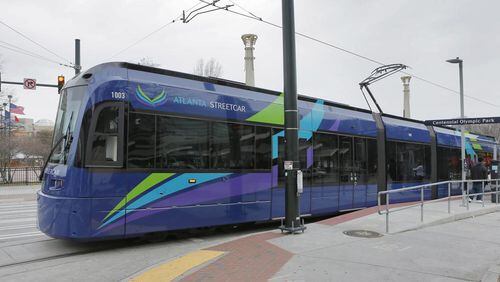Mayor Kasim Reed's office issued the statement below about The Atlanta Journal-Constitution's two-part look at lingering problems with the Atlanta Streetcar.
Part one of the series: Work remains to address Atlanta Streetcar audit
Part two of the series: Atlanta Streetcar ridership plummets, and many don't pay
Reed Administration Response to Atlanta Journal-Constitution Stories on the Atlanta Streetcar
Statement by Thomas Sabulis
ATLANTA – "Sunday's Atlanta Journal-Constitution headline on the Atlanta Streetcar should have read 'State officials pleased with Streetcar progress.' That's the first piece of new information the story shares, but readers don't see it until the seventh paragraph, when they learn that 'GDOT has accepted Atlanta's plans to fix all of the outstanding issues' raised in last year's audit (emphasis added).
A fair reading of GDOT's comments and an objective analysis of the Streetcar's current status should find that the Streetcar has made substantial progress in addressing safety and security issues raised by regulators. But the AJC's David Wickert does not provide a fair reading or an objective analysis. Rather, he takes an inherently anti-transit position designed for the paper's North Metro readership, not for readers in Atlanta. He does so at the expense of truth, context and objectivity.
This is nothing new from our state’s paper of record or its corporate partners at Channel 2. From the first days of passenger service, these outlets have run dozens of stories attacking the Atlanta Streetcar, with the goal posts always shifting. Despite these negative stories, the majority of Atlanta residents support the Streetcar.
The Atlanta Streetcar is fully focused on the future. The Streetcar's current 2.7 mile route was designed as Phase 1 of the project – a stake in the ground – not a stand-alone system. Expansion was always part of the overall system plan. In fact, the most frequent comment the City and its Streetcar partners hear is that people want it to go more places – they want it to expand. The next step is to connect the Streetcar to the Atlanta BeltLine, linking these two forward-looking transit projects. The Atlanta Streetcar is in the black and within its current operating budget. We believe we will be able to apply the valuable lessons learned during the design and construction of the initial leg of the Atlanta Streetcar to the expansion project, and finally, we believe Atlanta residents and visitors will respond to the expansion by making the Streetcar a regular part of their lives.
After our state partners raised valid concerns early last year, we worked hard and in close collaboration with the state, as well as with MARTA and ADID, to address these issues quickly and completely. Again, GDOT has accepted our plans for all 66 action items, and has agreed to completely close out 20 of those items. We are now in the process of closing out the remaining action plans.
Our progress has been possible because of our successful partnership with MARTA and our short-term contracting with TransDev, a leading private transit company. We also made additional strategic hires, including Executive Director Marwan Al-Mukhtar, which have added considerable experience and expertise to our team. All safety and security positions are fully staffed, as are all Streetcar operator positions. We believe the results are evident, as with the Streetcar’s 96 percent on-time performance.
Although the AJC failed to mention the agency in its two stories, MARTA has been involved from day one, and will remain involved even as the Streetcar deepens its bench and begins to transition away from MARTA oversight. The City of Atlanta is also working hand in hand with MARTA on its $2.6 billion, 40-year expansion within city limits. This plan calls for light rail transit along the full length of the BeltLine.
Wickert ignores the fact that a citywide system plan has always been the goal. He quotes Benita Dodd, a long-time critic who seeks to promote an anti-transit political agenda out of step with Atlanta’s business community, and William Perry, a person who lacks in any expertise in transit planning and management. Perry is also a steadfast opponent of the Mayor, and will take any opportunity he can to try and tarnish the Administration. If we are to take the AJC seriously in its coverage of transit and the Streetcar, they must find more credible and objective voices.
AJC readers also expect necessary context. In his Monday follow-up story, Wickert compares ridership and revenue figures to other systems, including Portland. The Portland Streetcar is widely seen as the nation's most successful, model system, but The Oregonian reported just last week that only about half of the system's riders pay the $1 fare. In response, Portland fare enforcement officers will start issuing $175 citations to any passenger without a valid ticket. Fare evasion is a problem facing all systems, but readers wouldn't learn that from the AJC.
Wickert also fails to connect the dots in his comparison between the Atlanta Streetcar and similar systems elsewhere. He points out that the Tampa-St. Petersburg system has a higher farebox recovery, but fails to point out its much lower ridership. Among the list of comparable systems, the Atlanta Streetcar is still one of the more popular and frequently used. Revenue and ridership are important, but by no means are they the only standards by which to judge success.
Leaders and advocates who care about our city’s future are sticking with transit. Midtown Atlanta’s boom of new business relocations and residential development is directly linked to transit access. In the last 43 months, 17 businesses have chosen to bring their corporate or regional headquarters to Atlanta. Even when they’ve chosen to build outside city limits, corporations are choosing transit. Mercedes-Benz USA and State Farm are two obvious examples.
Even if the AJC chooses to downplay the economic activity in downtown Atlanta, the paper can't argue with this fact: since the Transportation Investment Generating Economic Recovery (TIGER) II funding was first announced, more than $2.5 billion of new investments have been made within a five-minute walk of the Streetcar line. In his meetings with developers, investors and CEOs, Mayor Kasim Reed has repeatedly heard these leaders state that the Atlanta Streetcar has been a major factor in their decision-making. They see the City of Atlanta's long-term investment in the Streetcar as a sign of certainty, and an indicator of future investment in downtown neighborhoods and connectivity.
From the first conversations about the idea of a Streetcar, civic and business leaders saw an opportunity to build out the first component of a new, citywide transit system. They saw the opportunity to catalyze economic development downtown and in the Sweet Auburn District and the Historic Old Fourth Ward. They saw the opportunity to connect neighborhoods that had been separated from one another by the Interstate. They saw the opportunity to connect the Dr. Martin Luther King, Jr. Center and Historic Site to downtown attractions such as the World of Coca Cola, the Georgia Aquarium and the new Center for Civil and Human Rights and the College Football Hall of Fame. They also saw the opportunity to provide a convenient, safe option for the nearly 50 million people who visit Atlanta each year to access these landmarks and attractions.
Building the Atlanta Streetcar was a decision made thinking five, ten, twenty years ahead. Atlanta has benefited from leaders making these kinds of long-term decisions: consider the initial skepticism for GA-400 and how it has transformed North Fulton, or Freedom Parkway opening up the Eastside of Atlanta.
All across the country, cities are pursuing light rail and streetcar transit for several reasons. These systems promote greater density and urbanism. They are more affordable than heavy rail and more desirable than buses. And they can be designed and built relatively quickly. That’s why the competition for the TIGER II grant was so fierce. The U.S. Department of Transportation received nearly 1,000 construction grant applications, worth more than $19 billion, from all 50 states, U.S. territories and the District of Columbia.
Atlanta voters made their wishes clear when they overwhelmingly approved both the $2.6 billion MARTA expansion and the $400 million TSPLOST on the November ballot. Like the Streetcar, these are long-term investments in our city.
It’s unfortunate that the AJC continues to attack transit. They do so at the expense of their own credibility. People in Atlanta still support the Streetcar because their day to day lives tell a different story than what’s found in the pages of the newspaper. They are living a different experience.
We’re building the kind of future we want to see. Contrary to what AJC editors and reporters might think, this future is connected, dense and urban. And the Atlanta Streetcar is right there in the mix.”
###







